
- Beaver Cowboy Hat
- Brand
- American Hat Company (32)
- Bailey (62)
- Beaver (8)
- Beaver Brand (47)
- Beaver Hats (19)
- Belmonti (14)
- Bradford (9)
- Charlie 1 Horse (12)
- Handmade (8)
- Hatco (8)
- Larry Mahan (8)
- Old West (37)
- Resistol (619)
- Rodeo King (72)
- Serratelli (46)
- Stetson (1047)
- Stratton (7)
- Texas Hatters (8)
- Western (11)
- Wrangler (9)
- ... (677)
- Department
- Material
- 10x Beaver (7)
- 3x Beaver (11)
- 4x Beaver (8)
- 6x Beaver Fur (27)
- Beaver (1498)
- Beaver Felt (73)
- Beaver, Felt (7)
- Beaver, Fur (48)
- Beaver, Fur Felt (16)
- Beaver, Fur, Wool (10)
- Beaver, Leather (6)
- Beaver, Wool (7)
- Felt (53)
- Fur (162)
- Fur Felt (38)
- Fur Felt, Beaver (5)
- Fur, Beaver (9)
- Leather (12)
- Wool (25)
- Xxxxx Beaver (5)
- ... (733)
- Size
- Style
- Cattleman (10)
- Cowboy (191)
- Cowboy / / Western (4)
- Cowboy / Western (16)
- Cowboy Hat (1951)
- Cowboy Western Hat (2)
- Cowboy, Western (12)
- Derby (4)
- Fedora (32)
- Fur Felt (18)
- Hat (4)
- Open Crown (3)
- Open Road (8)
- Open Road Cowboy Hat (4)
- Rancher (6)
- Stetson (5)
- Tom Mix Gus (3)
- Western (39)
- Western Cowboy (9)
- Western Hat (5)
- ... (434)
- Theme
- 80s (6)
- 90s, Western (6)
- American (11)
- American, Western (7)
- Band (10)
- Classic (13)
- Classic, Western (7)
- Cowboy (72)
- Cowboy, Usa, Western (5)
- Cowboy, Western (87)
- Metal (5)
- Rancher (5)
- Texas (9)
- Usa (61)
- Usa, Western (17)
- Vintage (7)
- Western (1480)
- Western, Cowboy (21)
- Western, Cowboy, Usa (4)
- Western, Vintage (22)
- ... (905)
Sz 7 1/4 Restored Vintage 1950s Resistol 20X Beaver Felt Gus Tom Mix Cowboy Hat
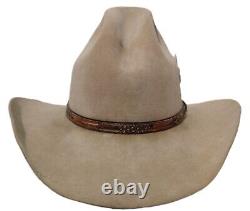

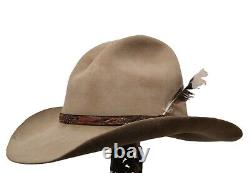
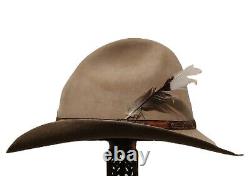


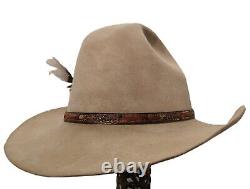
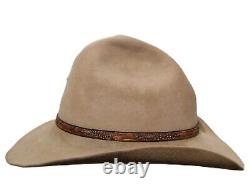
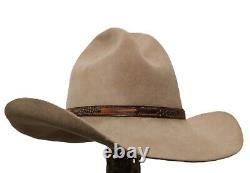
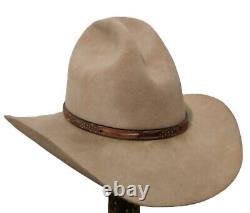

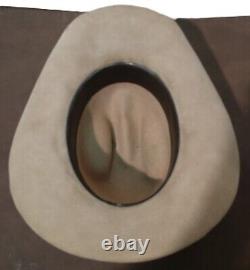
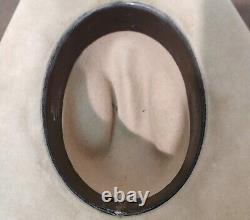
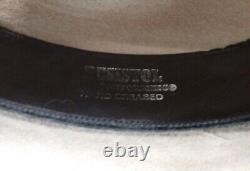
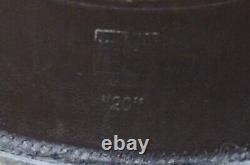
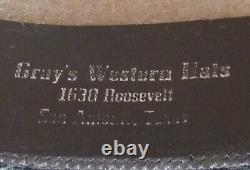
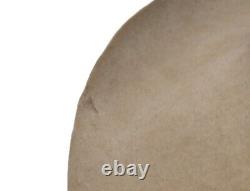


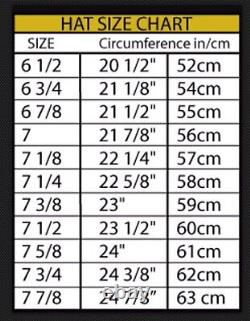


Vintage 1950s Resistol "Plains" Beaver Fur Felt Fedora Western Cowboy Hat, Size 7 1/8. Estimated Era of Manufacture: 1950s. Size: 7 1/4 (Hat has been carefully measured at 22 5/8 or 58 cm which confirms its size as a 7 1/4 US). Retailer: Grey's Western Hats, San Antonio Texas.
Rown Height: 6 with Gus crease. Ense and tight, of medium thickness with plenty of beaver fur content to hold its shape well. Hat Band: Unique leather and feather band about 5/8 wide with a wild gull feather accent.
Sweat Band: For its age the sweat is still relatively soft and supple, and f. Irmly attached to felt with n. Print is fairly worn off indicating this was once someone's favorite hat and worn often. That's probably why it has such great patina.
When I say a hat has a nice patina, please don't confuse that with dirt, sweat or grime. Like all my restored hats, this one has been thoroughly cleaned to remove all the icky and any associated smell. What sometimes remains with a well worn hat is some slight discoloration in certain areas that gives the hat a nice distressed look. When purchasing their hat new some p. Eople pay extra for this effect. Just add the hat and box to your cart.If by chance your hat doesn't fit in the box you pick I'll let you know and I'm sure we can work it out somehow. Repair Note: As seen in the last two pics of the hat, l. Ooking down from the top of at about 7:00 there was a small, roughly 1/4 cut right at the edge of the brim that I've repaired with a professional technique involving a few stitches and a. Special adhesive specifically formulated for felt repair.
As long as you don't pick at it, or try to pull it apart, this is a permanent repair that's actually stronger than the felt and disguised with. A thin layer of felt permanently bonded to the surface that covers the repair.
Please see my other listings for more hats and various hat accessories. I'm very proud of the many nice comments from my previous customers. I'm a retired gentleman with a lifelong love for fine quality western style hats. I've collected many hats in my life and developed a network for acquiring more all the time. I typically maintain an inventory of several hundred hats in various stages of restoration. Over the years I've learned a number of restoration techniques from professional hatters and developed my own hat restoration process that I'm constantly refining. I do it out of love and appreciation for the superior quality that went into making these old hats at a time when pride in workmanship and creating a product with enduring value really meant something.One of my favorite qualities of a nice felt hat is its durability and the dramatic metamorphosis that takes place when I transform a dirty, old, neglected, misshapen hat into something beautiful; a hat that looks brand new, ready to bring enjoyment to its proud new owner for another lifetime. My Restoration Process (not applicable to this particular hat). My 3 step deep cleaning process removes any unsightly stains or odors.
Then each hat is reblocked tight to return it to its original open crowned and flat brimmed form. After reblocking the condition of the sweatband is inspected.
If the leather is found to be brittle, cracked or damaged, I patch and reinforce it with a pliable backing strip bonded to the back. By preserving rather than replacing the original sweatband all the important brand and quality information is retained. Then each hat is steamed shaped by hand and stiffened with a professional grade shellac solution. If it came with one, the cleaned silk liner is reinstalled and a hat band is applied. X value depends on age If you're shopping for a new hat the "X" system is useful for comparing hats of the same brand, but with vintage hats more consideration should be placed on when the hat was made.
Generally speaking, the older the hat the more beaver fur was incorporated into the felt, which with western style hats translates to a thinner, stiffer felt and a lighter weight, higher quality hat. Hats beyond a certain age didn't use "Xs" and relied on the price to communicate quality. Back around the 1910s or 20s when Stetson first started giving their hats an "X" designation the 7X was their top end hat, but most of their hats didn't get any Xs at all. A fellow eBayer recently sent me a 1922 Stetson price list and from most to least expensive it went 7X, 5X, 4X, 3X, Real Nutria, Nutria, No. 1 Quality, Extra Quality, Excellent Quality, and Select Quality, so the original Stetson 3X cost more and was higher quality than the No. That's why whenever I see a 1920s or 30s Stetson 3X priced low I snap it up quick. There's simply no comparison between an early Stetson 3X and the current Stetson 3X which is made of 100% wool. The problem Stetson ran into with their new X system is there's no "FDA" of hats, so there was nothing to prevent company XYZ from marking their inferior hats with 10, 100 or even 1000 Xs.So the X race was on, and over the decades there's been substantial Xflation. X value depends on maker. As much as I love those early Stetson 3X hats, I'm pretty sure the earliest 3X Resistol hats are even higher quality. But when other hat makers started putting more Xs on their hats the whole industry followed suit. This is how Xflation got extreme, but also uneven.
For example, if Stetson's thousand dollar hat is a 100X, and that same year Larry Mahan's thousand dollar hat was marked 500X, is the Larry Mahan a better hat? Well, maybe or maybe not. Is it 5 times better quality than the Stetson, and therefore some kind of amazing deal? The simple answer is no, but the truest answer is probably which hat do you prefer? Depending on the blend fur felt can have a wide range of properties, from thinner to thicker, softer to stiffer to color, texture, and sheen, your own subjective preferences have a role to play.The one that feels right on your head and makes you feel good when you wear it is the best quality hat for you.

